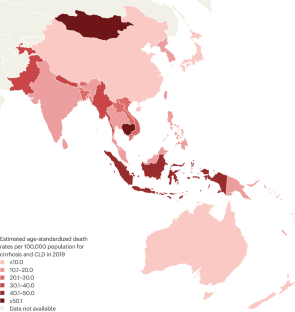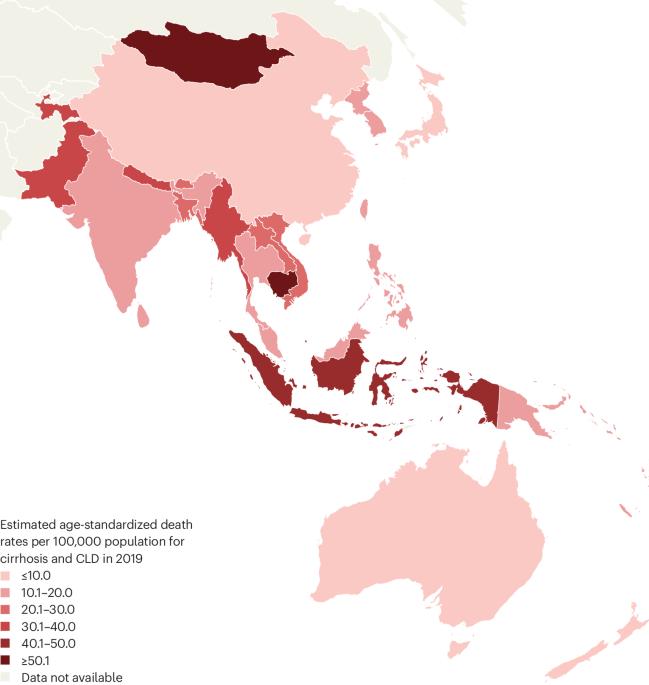Liver diseases and hepatocellular carcinoma in the Asia-Pacific region: burden, trends, challenges and future directions
IF 45.9
1区 医学
Q1 GASTROENTEROLOGY & HEPATOLOGY
引用次数: 0
Abstract
Globally, nearly half of deaths from cirrhosis and chronic liver diseases (CLD) and three-quarters of deaths from hepatocellular carcinoma (HCC) occur in the Asia-Pacific region. Chronic hepatitis B is responsible for the vast majority of liver-related deaths in the region. Metabolic dysfunction-associated steatotic liver disease (MASLD) is the most common form of CLD, affecting an estimated 30% of the adult population. Compared with people of European descent, people from the Asia-Pacific region carry more genetic variants associated with MASLD and its progression. Alcohol is a fast-growing cause of CLD and HCC in Asia as a result of the rising per-capita consumption of alcohol. Drug-induced liver injury is under-recognized and probably has a high prevalence in this region. The epidemiological and outcome data of acute-on-chronic liver failure are heterogeneous, and non-unified definitions across regions contribute to this heterogeneity. CLDs are severely underdiagnosed, and effective treatments and vaccinations are underutilized. In this Review, we highlight trends in the burden of CLD and HCC in the Asia-Pacific region and discuss the rapidly changing aetiologies of liver disease. We examine the multiple gaps in the care cascade and propose mitigating strategies and future directions. Mortality related to liver diseases and liver cancer is high and on the rise in the Asia-Pacific region. This Review summarizes the current epidemiological data and discusses the changing landscape of burden and aetiology of liver disease and liver cancer in the Asia-Pacific region.


亚太地区的肝病和肝细胞癌:负担、趋势、挑战和未来方向
在全球范围内,近一半死于肝硬化和慢性肝病(CLD)的人以及四分之三死于肝细胞癌(HCC)的人都发生在亚太地区。慢性乙型肝炎是该地区绝大多数肝脏相关死亡的原因。代谢功能障碍相关性脂肪性肝病(MASLD)是最常见的CLD形式,估计影响到30%的成年人口。与欧洲后裔相比,亚太地区的人携带更多与代谢功能障碍相关性脂肪肝及其进展有关的基因变异。在亚洲,由于人均饮酒量不断增加,酒精是导致慢性肝病和肝癌的一个快速增长的原因。药物性肝损伤在该地区的发病率可能很高,但却未得到充分认识。急性-慢性肝功能衰竭的流行病学和结果数据各不相同,各地区的定义不统一也是造成这种异质性的原因之一。慢性肝功能衰竭的诊断严重不足,有效的治疗和疫苗也未得到充分利用。在这篇综述中,我们强调了亚太地区慢性肝病和肝癌负担的趋势,并讨论了快速变化的肝病病因。我们研究了护理流程中的多个缺口,并提出了缓解策略和未来发展方向。
本文章由计算机程序翻译,如有差异,请以英文原文为准。
求助全文
约1分钟内获得全文
求助全文
来源期刊
CiteScore
52.30
自引率
0.60%
发文量
147
审稿时长
6-12 weeks
期刊介绍:
Nature Reviews Gastroenterology & Hepatology aims to serve as the leading resource for Reviews and commentaries within the scientific and medical communities it caters to. The journal strives to maintain authority, accessibility, and clarity in its published articles, which are complemented by easily understandable figures, tables, and other display items. Dedicated to providing exceptional service to authors, referees, and readers, the editorial team works diligently to maximize the usefulness and impact of each publication.
The journal encompasses a wide range of content types, including Research Highlights, News & Views, Comments, Reviews, Perspectives, and Consensus Statements, all pertinent to gastroenterologists and hepatologists. With its broad scope, Nature Reviews Gastroenterology & Hepatology ensures that its articles reach a diverse audience, aiming for the widest possible dissemination of valuable information.
Nature Reviews Gastroenterology & Hepatology is part of the Nature Reviews portfolio of journals.

 求助内容:
求助内容: 应助结果提醒方式:
应助结果提醒方式:


